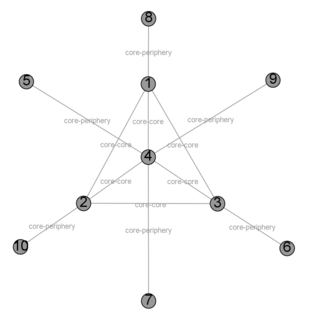Core–periphery structure
Network theory model From Wikipedia, the free encyclopedia
Core–periphery structure is a network theory model.
This article has multiple issues. Please help improve it or discuss these issues on the talk page. (Learn how and when to remove these messages)
|

Models of core–periphery structures
Summarize
Perspective
There are two main intuitions behind the definition of core–periphery network structures; one assumes that a network can only have one core, whereas the other allows for the possibility of multiple cores. These two intuitive conceptions serve as the basis for two modes of core–periphery structures.
Discrete model
This model assumes that there are two classes of nodes. The first consists of a cohesive core sub-graph in which the nodes are highly interconnected, and the second is made up of a peripheral set of nodes that is loosely connected to the core. In an ideal core–periphery matrix, core nodes are adjacent to other core nodes and to some peripheral nodes while peripheral nodes are not connected with other peripheral nodes (Borgatti & Everett, 2000, p. 378). This requires, however, that there be an a priori partition that indicates whether a node belongs to the core or periphery.

Continuous model
This model allows for the existence of three or more partitions of node classes. However, including more classes makes modifications to the discrete model more difficult.[clarification needed] Borgatti & Everett (1999) suggest that, in order to overcome this problem, each node be assigned a measure of ‘coreness’ that will determine its class. Nevertheless, the threshold of what constitutes a high ‘coreness’ value must be justified theoretically.
Discussion
Hubs are commonly found in empirical networks and pose a problem for community detection as they usually have strong ties to many communities. Identifying core–periphery structures can help circumvent this problem by categorizing hubs as part of the network's core (Rombach et al., 2014, p. 160). Likewise, though all core nodes have high centrality measures, not all nodes with high centrality measures belong to the core. It is possible to find that a set of highly central nodes in a graph does not make an internally cohesive subgraph (Borgatti & Everett, 2000)...
Uses in economics
Summarize
Perspective
The concept was first introduced into economics as "centre-periphery" by Raúl Prebisch in the 1950s, but the origin of the idea could ultimately be traced back to Thünen's Isolated State (1826).[1] However, the qualitative notion that social networks can have a core–periphery structure has a long history in disciplines such as sociology, international relations (Nemeth & Smith, 1985), and economics (Snyder & Kick, 1979). Observed trade flows and diplomatic ties among countries fit this structure. Paul Krugman (1991) suggests that when transportation costs are low enough manufacturers concentrate in a single region known as the core and other regions (the periphery) limit themselves to the supply of agricultural goods.
The "centre-periphery" model was classically developed by John Friedmann in 1966 in his book Regional Development Policy: A Case Study of Venezuela.[2]
For regional relations and variations in Russia Professor Natalia Zubarevich proposed an extension of the centre-periphery model and is known as the author of the "theory of four Russias".[3] According to Zubarevich, the different speed of social modernisation is more accurately explained by the centre-periphery model. The entire population of the country can be divided into three roughly equal parts - about a third of citizens in each. The underdeveloped republics, where 6% of the country's population lives - this "fourth" Russia has its own specific features.[4][5][6] According to the concept, "First Russia" is the cities with millions of inhabitants, i.e. the most modernised and economically developed territories. "Second Russia" are medium-sized cities with a pronounced industrial profile. "Third Russia" - small towns, workers' settlements, rural areas. Compared to "first" and "second Russia" - this is a deep periphery in terms of the quality of socio-economic life. The "fourth Russia" is made up of the national republics of the Caucasus, as well as the south of Siberia (Tuva, the Altai Republic). These territories also represent a periphery, but a specific one: the demographic transition has not been completed here, urbanisation is in its infancy, and patriarchal-clan principles are still strong in society.[7] Monoprofile towns (monotowns) are the most unstable part of the "second Russia".[8]
See also
References
Wikiwand - on
Seamless Wikipedia browsing. On steroids.
